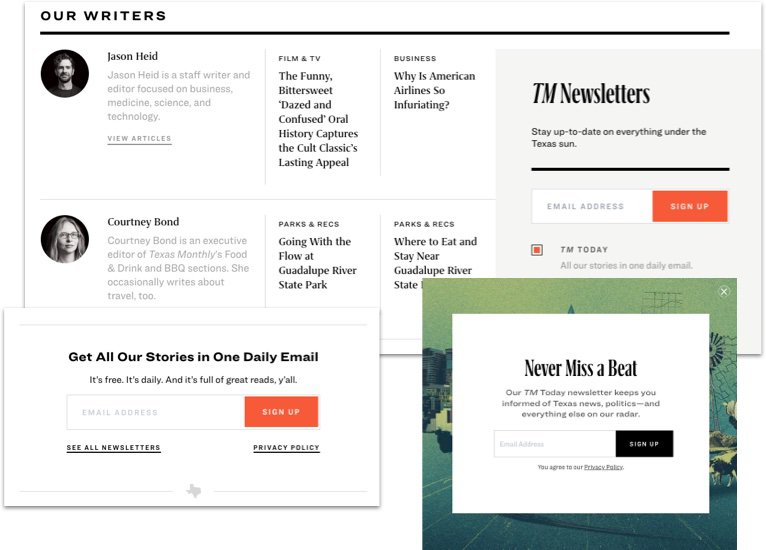
Email has long been a trusty tool for online magazines and alternative newspapers. It allows publishers to engage with their most loyal readers. It drives website traffic. It opens up new revenue opportunities. But growing an email list can be time-consuming. Thankfully, your website can help you out. Here are great ways to use your website to attract new email subscribers.
Meet readers where they are.
Metro Publisher makes it easy for publishers to place newsletter signup forms across their website. The placement will vary based on each publisher’s needs, but generally, prompt visitors to sign up for your emails in the following places:
- At the end of each article
- As a link in the footer
- On homepage and section landing pages
- Within checkout forms for subscriptions and event tickets
- On pop-up forms
For longform stories, consider placing a newsletter signup sprocket within the article as well. (If you are a current Metro Publisher user, you can set this feature up using the landing page builder.)
If you have multiple newsletters—say, a breaking news email, a dining email, and an arts email—create a different signup sprocket for each of these emails. You should also create a general newsletter signup sprocket. Place only the dining email signup sprocket within the dining section. Place only the arts email signup sprocket within the arts section. Save the general signup sprocket for the homepage.
As you are creating your sprockets, change the design of each to suit its placement on your site. For example, Texas Monthly uses a large comprehensive newsletter signup sprocket on their homepage. At the end of each article, they place a pared-down sprocket that prompts readers to sign up for the newsletter most relevant to the article’s content. And when a user begins to exit the website, a simple popup sprocket prompts them with one last-ditch appeal.
Require readers to provide their email to see exclusive content, join a membership program, or browse more easily.
We’ve written about several successful membership programs launched by online magazines and alternative newspapers like INDY Week and The American Prospect. One of the ways that these publications grow their membership program is by first converting their loyal readers to email subscribers.
When a visitor goes to The Devil Strip’s website, for instance, they can browse a few articles before a popup prompts them to sign up for a free editorial newsletter. Once a visitor has submitted their email, The Devil Strip staff will send them occasional emails promoting their membership program. When a reader signs up for the membership program, they receive early access to content, a say in what the publication covers, and no more pop-up forms, among other things.
Some publications also offer free downloads in exchange for email addresses. In 2020, D Magazine teamed up with Dallas-based artists to create a custom coloring book. Any website visitor who provided their email received the coloring book for free.
Host a contest or giveaway.
One of the fastest ways to grow your database with engaged readers is to host a contest or giveaway on your website. Many alternative newspapers and magazines are already familiar with running successful readers’ choice polls, which require voters to enter their email address to participate. Providence Journal’s 2020 best-of campaign brought in almost half a million votes and added 9,600 new emails to their database.
But shorter contests and giveaways can also attract readers. This month-long Mothers’ Day giveaway run by a St. Cloud-based radio station received more than 200,000 entries.
And of course, never underestimate the power of the Birthday Email. Offering personalized emails to readers on their birthday not only incentivizes email signups, it also activates email subscribers who haven’t opened an email in a while. 20,000 people are signed up for Distinctly Montana Magazine’s birthday email, which includes subscription offers and coupons.
To run a contest or giveaway on your site, sign up with a third-party promotional software like Second Street or ShortStack. The third-party software will generate HTML code for you, so that you can embed your contest on any webpage. If you have a smaller audience, you may be able to get away with running the contest through a simple form embedded on your site. But this strategy will become cumbersome as your audience grows.
Create a quiz or survey.
Surveys and quizzes can also convert website visitors to email subscribers. This five-question personality quiz sponsored by publisher Timbuktu Labs, Inc netted more than 3,000 leads in a month. And this historical trivia challenge created by Connecticut Public brought in 1,200 email subscribers for a new email that has an open rate over 30%. And don’t forget about surveys to appeal to readers for feedback. These simple forms can be a great way to convert loyal website visitors (and social media followers) to email subscribers. Appeal to website visitors with a survey when you’re planning your editorial calendar for a year, crafting a new newsletter, brainstorming events, or just want to check in with your audience.
